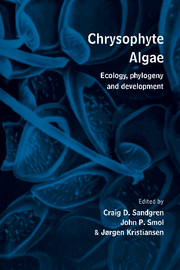Book contents
- Frontmatter
- Contents
- Preface
- List of contributors
- 1 History of chrysophyte research: origin and development of concepts and ideas
- Part I Phylogeny, systematics and evolution
- Part II Development, physiology and nutrition
- Part III Ecology, paleoecology and reproduction
- Part IV Contributed original papers
- Index of scientific names
- Subject index
1 - History of chrysophyte research: origin and development of concepts and ideas
Published online by Cambridge University Press: 05 March 2012
- Frontmatter
- Contents
- Preface
- List of contributors
- 1 History of chrysophyte research: origin and development of concepts and ideas
- Part I Phylogeny, systematics and evolution
- Part II Development, physiology and nutrition
- Part III Ecology, paleoecology and reproduction
- Part IV Contributed original papers
- Index of scientific names
- Subject index
Summary
This account covers a period of about 200 years – from the early beginnings of light microscopy until electron microscopy became established in the middle of the twentieth century. It takes its beginning in the middle of the eighteenth century, in rural Denmark at idyllic Frederiksdal, a manor house 20 km north of Copenhagen. In 1750, Countess Catharina Schulin had lost her husband Count Johan Siegesmund Schulin, who had held a high position in the Danish government administration. She was left alone with two children, a large estate, and an enormous staff of servants. She sought comfort in religion and summoned young theology students from the University to preach for her (Anker 1943).
Among these was 20-year-old Otto Friedrich Miiller (Fig. 1.1). He won the friendship of the countess, and after 3 years he was appointed as a private tutor to her young son. He took this position very seriously, so that the young count at the age of 10 years and 9 months was able to pass the entrance examination to the University. Later, Miiller accompanied the young count on the European tour that was traditional for young noblemen.
Müller had leisure time during his appointment and the beautiful surroundings of Frederiksdal stimulated his interest in natural history. Countess Schulin was interested not only in religion, but also in many aspects of culture and science. She was extremely pleased with Müller's service and encouraged and supported him in his scientific studies.
- Type
- Chapter
- Information
- Chrysophyte AlgaeEcology, Phylogeny and Development, pp. 1 - 22Publisher: Cambridge University PressPrint publication year: 1995
- 1
- Cited by



